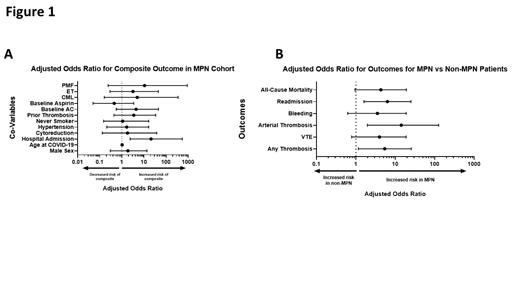Abstract

Background: Coronavirus disease-2019 (COVID-19) is an inflammatory, multisystem infectious disease caused by severe acute respiratory syndrome-coronavirus-2 (SARS-COV-2) and is associated with increased risk of thrombosis, particularly among critically ill patients. The myeloproliferative neoplasms (MPNs) include Philadelphia chromosome-negative (Ph-negative) MPNs polycythemia vera (PV), essential thrombocytosis (ET), and primary myelofibrosis (PMF), and Philadelphia-chromosome positive chronic myeloid leukemia (CML). Patients with MPNs, especially PH-negative, have increased risk of thrombotic complications. Given the increased propensity of thrombosis and prognostic significance of thrombosis in both COVID and MPNs, defining the risk of thrombotic complications in this patient population compared to the general population is important.
Methods: Using an institutional database within the Mass General Brigham integrated health network, we retrospectively analyzed 63 consecutive patients with MPN who were ≥ 18 years old and tested positive for SARS-COV-2 infection based on polymerase chain reaction (PCR) testing from March 1, 2020 to January 1, 2021. We compared patients admitted to the hospital in our "MPN cohort" with patients admitted to the hospital from a separate COVID-19 (non-MPN cohort) Mass General Brigham registry of 1114 consecutive patients who tested positive for SARS-COV-2 infection based on PCR testing from March 13, 2020 to April 3, 2020. Care was taken to ensure the cohorts were mutually exclusive. The 90-day primary outcome for MPN cohort was a composite of all-cause death, any thrombosis (composite of arterial and venous thromboembolism [VTE]), International Society on Thrombosis and Haemostasis (ISTH) defined major and clinically relevant non-major bleeding. To identify risk factors for primary outcome in MPN cohort we used a multivariable logistic regression using age, sex, hospital admission status, MPN type, cytoreduction for MPN, hypertension, smoking status, baseline anticoagulation (AC), prior thrombosis (stroke, myocardial infarction or VTE) as co-variables. The 90-day outcomes of interest in our MPN vs non-MPN cohort analysis were any thrombosis, death, ISTH major and clinically relevant non-major bleeding and readmission for any reason. To assess impact of MPN status in hospitalized patients in our MPN vs non-MPN comparison, we used a multivariable logistic regression using age, sex, race, Hispanic ethnicity, ICU admission, treatment with steroids and/or Remdesivir, baseline AC and aspirin use, prior thrombosis (stroke, myocardial infarction or VTE), diabetes, heart failure, admission hematocrit, platelet count and D-dimer as co-variables. Continuous variables were compared using student t-test and categorical variables were compared using Fischer's Exact Test with a p value of < 0.05 considered significant.
Results: Of the 63 patients with MPN (23 with PV, 17 ET, 4 PMF, 15 CML, 4 other), 27 (43%) were admitted to the hospital for COVID-19 and 5 (8%) required ICU admission. The mean age of all MPN patients was 66, 84% were White, 8% Black and 10% Hispanic. Primary 90-day outcome occurred in 12 (19%) of MPN patients. In multivariable analysis, only admission to hospital was associated with increased odds of composite (aOR 21.11, 95% CI 2.38 - 546.40), Figure 1A. In patients with (n = 27) and without MPN (n = 399) who were admitted to the hospital, patients with MPN were older (mean age 70 vs 61, p = 0.0076), more likely to be White (89% vs 54%, p = 0.0004) and less likely to be Hispanic (7% vs 29%, p = 0.0158), less likely to be admitted to the ICU (19% vs 43%, p = 0.0138), and more likely to be treated with corticosteroids (30% vs 14%, p = 0.025) or remdesivir (41% vs 13%, p < 0.0001). After multivariable logistic regression, diagnosis of MPN was significantly associated with increased odds of thrombosis (aOR 5.38, 95% CI 1.15-25.38) and readmission (aOR 6.28, 95% CI 1.60-24.88), but not bleeding (aOR 3.51, 95% CI 0.62-18.87) or death (aOR 4.29, 95% CI 0.95-18.99), Figure 1B.
Conclusions: Thrombotic complications are common in patients with MPN and COVID-19, particularly if hospitalized for COVID-19. After multivariable analysis, MPN patients admitted for COVID-19 had a significantly increased risk of thrombotic complications compared with non-MPN patients.
Al-Samkari: Dova/Sobi: Consultancy, Research Funding; Novartis: Consultancy; Argenx: Consultancy; Rigel: Consultancy; Amgen: Research Funding; Agios: Consultancy, Research Funding; Moderna: Consultancy. Rosovsky: Janssen: Consultancy, Research Funding; BMS: Consultancy, Research Funding; Inari: Consultancy, Membership on an entity's Board of Directors or advisory committees; Dova: Consultancy, Membership on an entity's Board of Directors or advisory committees. Fathi: Agios/Servier: Consultancy, Other: Clinical Trial Support; BMS: Consultancy, Other: Clinical Trial Support; AbbVie: Consultancy, Other: Clinical Trial Support; Pfizer: Consultancy; Trillium: Consultancy; Kura: Consultancy; Blueprint Medicines Corporation: Consultancy; Genentech: Consultancy; Novartis: Consultancy; Trovagene: Consultancy; Daiichi Sankyo: Consultancy; Novartis: Consultancy; Morphosys: Consultancy; Kite: Consultancy; Foghorn: Consultancy; Takeda: Consultancy; Amgen: Consultancy; Seattle Genetics: Consultancy; NewLink Genetics: Consultancy; Forty Seven: Consultancy; Ipsen: Consultancy. Goldhaber: Bayer: Consultancy, Research Funding; Boehringer-Ingelheim: Consultancy, Research Funding; BMS: Research Funding; Boston Scientific BTG EKOS: Research Funding; Daiichi: Research Funding; Janssen: Research Funding; Pfizer: Consultancy, Research Funding; Agile: Consultancy. Piazza: Portola: Research Funding; Bayer: Research Funding; Amgen: Research Funding; BMS: Research Funding; Janssen: Research Funding; BSC: Research Funding. Hobbs: Celgene/Bristol Myers Squibb: Consultancy; Novartis: Consultancy; Merck: Research Funding; Constellation Pharmaceuticals: Consultancy, Research Funding; Bayer: Research Funding; Incyte Corporation: Research Funding; AbbVie.: Consultancy.
Author notes
 This icon denotes a clinically relevant abstract
This icon denotes a clinically relevant abstract


This feature is available to Subscribers Only
Sign In or Create an Account Close Modal